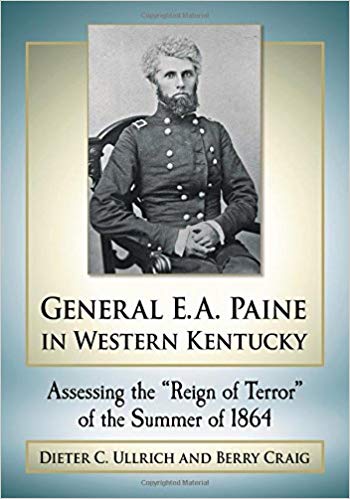General E.A. Paine in Western Kentucky: Assessing the “Reign of Terror” of the Summer of 1864 by Dieter C. Ullrich and Berry Craig. McFarland, 2018. Paper, ISBN: 978-1476671437. $39.95.
 Civil War history and memory are topics that have fascinated historians and incited public controversies for generations. In Kentucky, a loyal, slaveholding state whose sentiments drifted steadily southward as Union policy moved towards emancipation, the rhetorical battle for hearts and minds began well before the shooting stopped.
Civil War history and memory are topics that have fascinated historians and incited public controversies for generations. In Kentucky, a loyal, slaveholding state whose sentiments drifted steadily southward as Union policy moved towards emancipation, the rhetorical battle for hearts and minds began well before the shooting stopped.
In the last decade, several historians have demonstrated that white Kentuckians became “belated” Confederates after the ratification of the Thirteenth Amendment. Kentuckians began a long process of “forgetting” their allegiance to the Union and embracing the ideology of the Lost Cause in the half-century after Appomattox. Yet in far western Kentucky (a region known locally as the Jackson Purchase), such committed amnesia was unnecessary, for a “flood of secession fanaticism” (12) had shaped local history and historical fact into something approaching mythology since at least the spring of 1861.
Dieter C. Ullrich and Berry Craig’s General E.A. Paine in Western Kentucky is a notable effort to raise the eponymous Union officer from this realm of “folklore and myth” (2), thereby salvaging a reputation that has been unfairly tarnished by decades of misinformation. Along the way, Ullrich and Craig touch upon a number of themes that imbue this case study of Civil War memory with a wider appeal.
From discussions on the politicization of historical truth to a revealing glimpse of the violent guerilla campaigns in and around Paducah, the authors have presented a vivid account of the conditions that confronted Paine during his fifty-one-day tenure in western Kentucky in the summer of 1864. While this context is satisfying and often enlightening, the focus remains on Paine’s actions and reputation; Ullrich and Craig rarely stray from their stated objectives for long.
The argument throughout General E.A. Paine is rather straightforward: Paine was unfairly vilified by contemporary Kentuckians as a murderous “tyrant” due to his political beliefs and hardline stance towards Confederate sympathizers. A Republican from Illinois who believed in total war, African American equality, and the uncompromising punishment of known rebels, Paine found himself squarely at odds with the majority of whites in western Kentucky. In fact, it was his tough reputation and penchant for suppressing secessionists that led influential Unionists to push for his appointment as commander at Paducah.
In less than two months in 1864, Paine suppressed trade that aided the Confederacy, waged an unrelenting battle against lawless guerillas, boosted the morale of Union troops and supporters, and ably defended an area of more than 2,000 square miles. For his efforts, Paine earned the unadulterated hatred of pro-Confederates who successfully campaigned for his removal on trumped-up claims of abuse of power. Although cleared of all but one minor charge by the subsequent court martial, Paine had already entered local folklore as a fiend, denounced by Democrats and even conservative Republicans for his supposed “reign of terror” that allegedly oversaw dozens of illegal executions and otherwise trampled on the constitutional rights and liberties of white Kentuckians in the Jackson Purchase.
General E.A. Paine categorically refutes these claims through a considered presentation of historical fact. Ullrich and Craig do not spare Paine in their assessment: he appears as a zealous brigadier who ordered the execution of a handful of known guerillas and pushed his authority to its limits in pursuit of his unwavering judgment that “equated all but unconditional unionism with treason” (4). In other places at other times, of course, these were nearly the same actions that earned Grant, Sherman, Sheridan, and other Union officers the enmity of the white South. With the advantage of hindsight, it almost seems a foregone conclusion that Lost Cause apologists would find in Paine a pantomime villain who fit perfectly in the role of Yankee outsider and Union oppressor. As they looked, so they found.
From newspaper reports and biased histories to one-sided historical markers and the efforts of the United Daughters of the Confederacy, the authors demonstrate how fiction has replaced truth in the collective consciousness of the Jackson Purchase. Importantly, General E.A. Paine insists that historical truth matters. With the stakes as high as they are in regards to Civil War history and memory, Ullrich and Craig provide a timely reminder of just how vital it is to produce history rooted in fact.
Jacob A. Glover is a historian at Shaker Village of Pleasant Hill in Harrodsburg, Kentucky. His research focuses on nineteenth century Kentucky.
